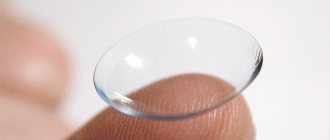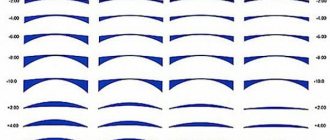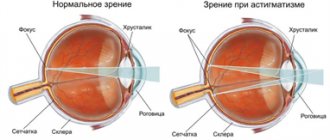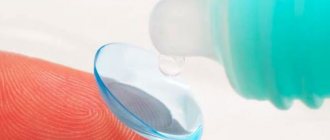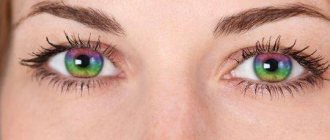When buying glasses, we first of all choose a beautiful frame that emphasizes our face. But glasses are primarily optics for correcting our vision, and not a fashion accessory for adding any image. If you purchase glasses without paying attention to their characteristics, you can develop vision problems. Therefore, the choice of lenses for glasses should be approached responsibly. This article will help you with this, from which you will learn about what types of lenses for glasses are, how to choose lenses, and you will also find many useful tips here.
Where to start choosing
The choice of lenses for glasses should always begin with a visit to your ophthalmologist. Only a specialist can write a prescription for glasses.
Before this, he must check visual acuity to determine what optical characteristics of the lenses (diopters, distance between the pupils) are suitable in this case.
For people who have been wearing glasses for a long time, before changing to new glasses, you should also visit an ophthalmologist. You need to make sure that your vision remains at the same level, and if it has dropped, the doctor will write a new prescription.
After the doctor has selected the appropriate optical power for the lenses, you need to go to the optician, where the specialists working there will select the correct frame for the lenses. There are many different types of frames in optics. You can choose for a very long time until you like some frame. It should be remembered that it should not only be beautiful and highlight the face or eyes, but also be comfortable and not cause discomfort. The temples of the glasses can be bent at your discretion to make them comfortable.
Choosing the type of lenses is one of the main stages. There are plastic and glass lenses, anti-reflective lenses, tinted lenses and others.
When choosing lenses for glasses, you should follow four main steps:
- Consultation with an ophthalmologist.
- Visit to the optician.
- Choice of frames.
- Selecting the type of lenses.
You can learn about the rules for wearing contact lenses in this material.
Definition of polymer lenses
Polymer spectacle lenses are lenses made from transparent organic plastics.
The most commonly used polymer is CR-39 . However, most manufacturers assign their own names to polymers.
Every year the popularity of such products is growing and polymer glasses are gradually replacing optics with mineral lenses from the market.
Frame selection
The frame is needed to hold the lenses in place. It should provide a convenient location for the lenses so that you can comfortably look through the glasses. The best location of the frame is considered to be one that ensures that the midline of the openings passes through the central points of the pupils, or slightly lower.
The main components of the frame are the frames and temples. The former ensure strong fastening of the lenses, and the latter are responsible for the position of the glasses. The two light openings of the frame are connected by the bridge of the nose.
In order for the frame to hold well, it can be supplemented with special nose pads, which provide a more stable fastening of the glasses. They are made of soft material such as silicone. The frame parts are attached to each other with hinges. If the hinges are made of high-quality material, then the frame will hold well and last quite a long time.
If you are allergic to metal, it is better to choose earhooks with silicone tips. They will also protect the head from compression if the arms are tight.
Types of frames:
- Bezel frames. In such frames, the light openings are completely enclosed in the rims. Rim frames are made from metal, plastic, or a combination of the two.
- Semi-rimless frames. Most often, the rim is located on the top of the openings. To ensure that the lenses hold well in the frame, it is supplemented with a nylon fishing line. The material used to make semi-rimless frames is similar to rimless frames.
- Rimless frames or “rimless” glasses. In this case, the lenses are attached with screws. This frame should be chosen by those who want to make glasses as inconspicuous as possible on their face.
In order for the frame to look beautiful on the face and not emphasize any flaws, you should take into account such individual characteristics as: face type, color type, wardrobe preferences.
- Almost all frames are suitable for people with oval faces. To make your face look a little smaller, you should pay attention to frames that are slightly wider than your face. If you want to hide a long nose, then you can choose large frames with a wide bridge of the nose, while the temples should be set low.
- For a round face shape, frames with clear, straight and pointed lines are suitable. To narrow your face, it is better to choose rectangular frames, and the temples should have a high rise.
- People with a triangular face shape should choose oval or round glasses for their vision. It’s good if there is some kind of accent on the bottom frame, it will make the chin less sharp.
- Oval frames will help hide the imperfections of a rectangular face. The absence of headbands will make facial features softer.
- People with a trapezoid-shaped face are advised to pay attention to cat-eye frames or frames with wide temples.
Regarding the choice of frames for a specific color type, then:
- For the autumn type, frames in brown and green colors and ivory shades are suitable. Please note that the metal frame should have a copper or gold color.
- For the winter type, it is better to choose transparent frames or frames in cool shades. The metal frame must be silver.
- For the spring type, delicate, soft shades of beige, blue, and yellow are suitable. Golden metal frames will beautifully highlight a spring-type face.
- For the summer type, sunny golden shades of the frame are suitable. Bright purple, lilac and other shades will beautifully highlight a tanned face.
You can read about eye exercises to improve vision in this article.
The most modern contact lenses
Which models should be classified as technologically advanced and modern? Such lenses should provide high quality vision, even if a person has a very severe form of refractive error. Just a few decades ago, choosing optics was quite difficult for severe myopia and hypermetropia, astigmatism and presbyopia. Today, aspheric, toric and multifocal lenses are used to correct these visual pathologies.
Another requirement that can be put forward to contact optics manufacturers is wearing comfort. Ophthalmic products should not cause discomfort or side effects. As a rule, you don’t even need to get used to modern lenses. They are ultra-thin, elastic and have a very smooth surface, and therefore are not felt on the eyeballs. In other words, they should be suitable for those prone to allergies, dry eye syndrome and increased sensitivity of the cornea, that is, almost all people.
Modern technological lenses are safe. They have optimal moisture content and gas permeability. Many styles can be worn flexibly, extended or continuously. This means that they can be left in front of your eyes overnight without harm to their health.
Almost all new lenses are equipped with special filters that block ultraviolet radiation, providing 95-99% protection from sunlight. Also, modern contact optics have an inversion indicator, which simplifies the operation process.
There may be other functional features and advantages for each model. Thus, ophthalmic products are produced that are resistant to protein or lipid deposits. Some manufacturers focus on the design or method of stabilizing the lenses. The main thing that the buyer must do is to undergo an examination by an ophthalmologist before purchasing optics, and then purchase it in a specialized store. Let's move on to the description of specific models.
Types of lenses
There are two types of lenses for glasses - glass and polycarbonate. Each of these types has its own advantages and disadvantages. Next we will consider these aspects in more detail.
Glass lenses
Advantages:
- Durability. Glass provides a high degree of stability.
- Do not become cloudy over time.
- They do not allow ultraviolet radiation to harm the eyes because they do not allow it to penetrate through them.
- Ability to change throughput when lighting changes.
- Can be supplemented with various coatings (anti-glare, polarizing, etc.). It all depends on the need and working conditions.
- High refractive index.
Flaws:
- Fragility. The glass can crack if hit or dropped, so you need to use these glasses carefully.
- For people suffering from astigmatism, it is difficult to find glass lenses, since the production of double-curved glass is difficult.
- Heaviness. After wearing for a long time, marks remain on the nose.
- Photochromic glass lenses in a gray or yellow tint have a slower ability to transmit light.
You can learn about tint contact lenses by following this link.
Polycarbonate lenses
Advantages:
- Ease. Polycarbonate is almost half the weight of glass.
- They do not break, so they are safe to wear. The risk of injury is minimal.
- Painting in any shade is allowed. Polycarbonate is easy to process.
- These lenses are great for people with astigmatism.
Flaws:
- Easy to scratch or cause mechanical damage. But high-quality polycarbonate allows you to avoid this.
Types of organic materials for spectacle lenses
Due to the fact that the pace of human life is becoming faster and faster, glasses must meet all the requirements. This led to the use of a large number of different materials for their manufacture.
For the manufacture of organic lenses the following are used:
- Polycarbonate - the material is lightweight, so it is often used for rimless glasses . It has good characteristics of optical refraction and resistance to mechanical damage. The structure of polycarbonate allows the production of very thin lenses.
- CR-39 is the most common material. Suitable for making glasses with small diopters . If the diopter value is over + or - 2, then the product will be quite thick.
- Trivex is a modern type of polymer with high optical refractive indexes. In terms of impact resistance, it is not inferior to polycarbonate. At the same time, it is lighter and has higher optical characteristics. It also has excellent resistance to chemicals. Trivex is excellent for making rimless optics.
- MR-10 is a modern advanced polymer with the highest refractive index. The material has excellent viscosity and elasticity. Therefore, lenses made from it are flexible and impact-resistant. In terms of impact resistance, it can be compared to polycarbonate . But at the same time it is much lighter and thinner. This explains the popularity of the polymer among leading manufacturers. It is used for the production of both standard and office and progressive glasses.
Lens color
Colored lenses allow you to make glasses more fashionable and unusual. Most often, it is polycarbonate lenses that are painted, since they are easily amenable to this procedure. The color of glasses lenses can be evenly distributed over the surface or have a smooth transition from dark to light. The second option is gradient painting, which is done either using several shades of the same color, or with completely different colors.
Colored lenses are a kind of color therapy. A certain color affects our well-being and mood differently.
- Warm shades lift your spirits and warm you with their warmth. And cool shades are invigorating.
- Red color is suitable for active, cheerful people. It will lift your spirits and give you good spirits. But the red color of the lenses is not suitable for people with increased nervous excitement and aggression.
- Yellow lenses are chosen by creative and self-confident people. This color is not suitable for people with high anxiety.
- Orange color invigorates and has a positive effect on the body as a whole.
- Pink lenses for glasses will visually make your face younger. Pink has a calming effect. Lenses of this color make it possible to relieve eye strain.
- Brown lenses are suitable for serious, calm people. This color gives a feeling of comfort and coziness.
- Blue color has a calming effect. It also stimulates brain function. Blue is suitable for people suffering from overstrain.
- Blue lenses are chosen by creative people, as well as those who want to feel lightness and freedom.
- Mysterious people prefer purple lenses. But it is worth remembering that this color is not suitable for people who are depressed.
- Green color has a beneficial effect on the eyes. It soothes and gives your eyes rest.
Reviews of night wear contact lenses can be found here.
Advantages of ultra-thin lenses
Such products have several advantages:
- Availability of protection against ultraviolet radiation;
- Can be installed in light and thin frames;
- No distortion, due to which there is no effect of bulging eyes, and visible objects are perceived by the eye without visual changes in shape and size;
- Light weight;
- Aspherical design;
- Reliability in operation.
Such lenses are more expensive than conventional ones due to the use of complex technologies in production to ensure a high refractive index. This cost is also explained by the use of expensive materials.
What you need to know when choosing lenses for glasses
Optical performance
Optical indicators include diopters and center-to-center distance. These indicators are determined by an ophthalmologist after he has carried out all the necessary studies to determine visual acuity.
It is necessary that the optical parameters be met, otherwise there will be no benefit from the glasses. To do this, you need to order glasses from good optics.
Refractive index
The main indicator that you should pay attention to when choosing a class of lenses for glasses is the refractive index.
If the lenses have a low refractive index, they will be slightly heavier and will slightly narrow the face and eyes in the area of the lenses. A high coefficient allows you to choose a more elegant frame.
The higher the refractive index, the thinner the lens and the more curvature it becomes.
Glass lenses are available with a refractive index from 1.5 to 1.9, and polycarbonate lenses - from 1.5 to 1.7. Low-index lenses have a coefficient of 1.5, and high-index lenses have a coefficient of more than 1.6.
Material
Eyeglass lenses are made of plastic (polycarbonate) and glass. Each of them has its own advantages and disadvantages. Here the choice is individual. The main thing to remember is that the refractive index of glass is higher than that of polycarbonate. Polycarbonate is easier to scratch, but has good impact resistance.
Anti-reflex lens coating
This lens coating allows you to improve its optical properties thanks to a special technology. The anti-reflex coating makes the lens ten percent clearer.
This makes the lens more comfortable, and the eyes are protected from fatigue under heavy load.
Another advantage of this coating is good vision in the dark.
Modern technologies for the eyes - polymer lenses
In the manufacture of organic lenses, in addition to plastic, special additives are used . Depending on the manufacturing method and structure, they are divided into two types: thermoplastics and thermosets. Thermoplastics are manufactured using injection molding. The most common material is polycarbonate . Its popularity is explained by the fact that polycarbonate is characterized by high resistance to mechanical damage.
The most popular CR-39 belongs to thermosets. According to its characteristics, the material is practically no different from glass . By adding other monomeric substances, CR-39 can be given additional properties, e.g. increase the amount of refraction.
The most modern polymer materials are tribrid and tryvex . They combine all the advantages of CR-39 and polycarbonate - they have excellent refractive index and are shock-resistant.
Pros of polymer lenses
Some believe that polymer optics are inferior in characteristics to mineral optics, for example, they do not have the same transparency. But modern polymers are not inferior to glass in their optical performance .
In addition, plastic products have a number of advantages :
- Light weight. Thanks to this, polymer glasses can be worn for a long time without experiencing discomfort.
- Plastic does not transmit ultraviolet radiation.
- Impact resistance and safety . Plastic can withstand shock loads. This is because plastic is a viscous material. Upon impact, it will not break into several fragments, which avoids possible eye injury.
- They have a high refractive index. This solved the problem of thick products. Organic glasses are thin, light and elegant.
- Plastic can be painted any color. This allows you to produce optics with any design.
Important! In many countries, almost all optics are made with organic lenses. This is due to the safety of this material. Glass glasses are used only by those people for whom they are recommended for medical reasons.
Minuses
The modern material has virtually no disadvantages; polymer optics have low abrasion resistance. If you wear glasses carelessly, they will quickly become covered with scratches.
Useful selection tips
- It is better to choose safe and unbreakable glasses for children. Therefore, it is better to choose polycarbonate as a lens material.
- People who spend a lot of time driving a car should choose colored lenses for their glasses. Green or brown lenses will enhance contrast, while yellow lenses will protect from the glare of headlights or street lights.
- Anti-reflective lenses are indispensable for those who work in front of cameras or take photographs.
- For those who work at a computer all day, it is recommended to choose lenses that will reduce eye strain. These glasses can be worn even with normal visual acuity. They will keep your eyes healthy.
Lens coating for prescription glasses
The main types of lens coatings are:
- strengthening;
- enlightening;
- anti-reflex (anti-glare);
- antistatic;
- hydrophobic (water-dirt-repellent).
| Coverage type | Functions | Coating device, features |
| Strengthening | Protects lens surfaces from mechanical damage such as scratches | Applied to the lens on both sides, it is the first (outer) level of coating |
| Enlightening | Reduces the amount of light reflected by the lens, allowing more light to reach the eye, providing the clearest and brightest picture possible | Can be applied in one, two or more layers, the more layers, the more light the coating can transmit |
| Anti-reflex | Prevents the appearance of glare on the outer surface of the lens, which looks unaesthetic and prevents other people from seeing the eyes of the interlocutor wearing glasses | Thanks to the anti-reflex coating, the lenses become almost invisible, and why glasses with such optics look stylish and modern |
| Antistatic | Prevents the formation of static electricity, which attracts dust to the surface of the lens | As a rule, this coating is applied as part of a multifunctional (complex) coating for optics |
| Hydrophobic | Increases lens resistance to contamination: optics with a hydrophobic coating repels water and dirt, reducing fogging when entering a warm room from a cold environment | If a hydrophobic coating is used as one of the lens coatings, it is applied as the final, outer layer |
Computer glasses
Computer glasses will protect your eyes from prolonged exposure to the monitor.
These glasses have a special coating on the lenses, which eliminates the negative effects of electromagnetic radiation. This allows you to maintain visual acuity when viewing a bright monitor and its constant flickering.
The main criterion for choosing glasses for a computer is the type of activity. When working with text documents, you should choose glasses that increase contrast and reduce the difference in halftones. To work with graphics, it is recommended to use lenses that will enhance color reproduction. For simple long-term stay in front of the monitor, glasses with an anti-reflective surface are suitable.
You can usually find glasses with universal lenses in opticians. Therefore, to find glasses for a specific job, you will have to search.
Before purchasing computer glasses, you should visit an ophthalmologist. He will recommend the required glasses. An optician or pharmacy must have certificates for glasses intended for working with a computer. The cost of such glasses should not be low. Cheap glasses can harm your eye health. If after wearing computer glasses you feel tired and tense in your eyes, it means that the glasses are not suitable for you or they are of poor quality. When using such glasses there should be no discomfort, itching or tension.
You can read about contact lenses with diopters here.
How to choose toric lenses, what they are used for, what they treat - you will learn all this when you follow the link.
Multifocal daily lenses:
You have not yet decided to replace your glasses with lenses, then read about how to choose them correctly and why they are useful in this article.
Which lenses are best for eyes?
On the one hand, the diversity of the contact products market facilitates the process of selecting lenses. Almost anyone can find a suitable model for themselves, regardless of the type of refractive error, its degree, eye sensitivity and other features. On the other hand, it is difficult to give preference to a specific pair of ophthalmic products due to the large selection of products. The easiest way is to turn to products from well-known manufacturers who have already proven themselves to be reliable.
All large companies have their own research and production base. They conduct research in the field of vision correction, look for pain points among the population, learn about the interests of customers, and based on the data obtained, they release new models - technologically advanced, functional and safe. Let's find out which lenses can be called the most modern.
conclusions
Choosing lenses for glasses is a rather difficult task. But if you approach it responsibly, you can cope with this task without any problems. Before you run to the optician for glasses, you should visit an ophthalmologist who will write out a prescription for glasses that is suitable for you. Only your doctor will tell you what type and material of lenses to choose. Taking good care of your eyes and following all the advice of a specialist will improve your vision and forget about various eye problems.
Today, a fairly popular phenomenon is to wear regular daily contact lenses and colored daily lenses.
Using Free Form technology
In the production of super-thin lenses, Free Form technologies are used, which make it possible to produce products that exactly match the parameters of the patients’ visual organs. Thanks to this approach, ready-made glasses can be fully used immediately without removing them during the day, since there is no adaptation period and a person does not need to get used to new features of vision.
During production, lenses with complex geometric surface shapes are obtained, which provides the best optical properties. For such precise processing, the smallest diamond cutters are used, and the entire process occurs automatically according to a predetermined program. This eliminates errors and inaccuracies.
The patented Free Form technology is used by many manufacturers producing thin and super thin lenses. During this manufacturing process, the equipment is adjusted based on parameters such as the shape and size of the intended frame, the angle of the lens, and the vertex distance (the distance from the back of the lens to the top of the cornea).
Lenses made using this technology not only meet all quality requirements for optical accessories, but are also the best examples of modern lenses.
